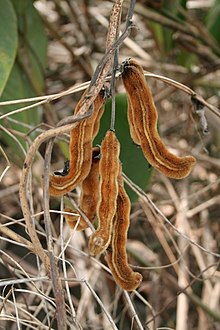pt-BR
nomes no trilho de navegação


Mucuna is a genus of around 114 accepted species of climbing lianas (vines) and shrubs of the family Fabaceae: tribe Phaseoleae, typically found in tropical forests.
The leaves are trifoliolate, alternate, or spiraled, and the flowers are pea-like but larger, with distinctive curved petals, and occurring in racemes. Like other legumes, Mucuna plants bear pods. They are generally bat-pollinated and produce seeds that are buoyant sea-beans. These have a characteristic three-layered appearance, appearing like the eyes of a large mammal in some species and like a hamburger in others (most notably M. sloanei) and giving rise to common names like deer-eye beans, donkey-eye beans, ox-eye beans, or hamburger seed.
The name of the genus is derived from mucunã, a Tupi–Guarani word for these species.[3]
Some Mucuna species are used as food plants by caterpillars of Lepidoptera. These include Morpho butterflies and the two-barred flasher (Astraptes fulgerator), which is sometimes found on M. holtonii and perhaps others. The plant pathogenic fungus Mycosphaerella mucunae is named for being first discovered on Mucuna.

The pods of some species are covered in coarse hairs that contain the proteolytic enzyme mucunain and cause itchy blisters when they come in contact with skin; specific epithets such as pruriens (Latin: "itching") or urens (Latinized Ancient Greek: "stinging like a nettle") refer to this. Other parts of the plant have medicinal properties. The plants or their extracts are sold in herbalism against a range of conditions, such as urinary tract, neurological, and menstruation disorders, constipation, edema, fevers, tuberculosis, and helminthiases such as elephantiasis.[4] In an experiment to test if M. pruriens might have an effect on the symptoms of Parkinson's disease, Katzenschlager et al. found that a seed powder had a comparable, if not more favourable, effect as commercial formulations of L-dopa, although the trial only consisted of four people per test group.[5]
M. pruriens was found to increase phosphorus availability after application of rock phosphate in one Nigerian experiment.[6] M. pruriens was used in Native American milpa agriculture.
Mucuna seeds contain a large number of antinutritional compounds. The most important is L-dopa, which the digestive system of most animals confuses with the amino acid tyrosine, causing the production of defective proteins. Other antinutrients are tannins, lectins, phytic acid, cyanogenic glycosides, and trypsin and amylase inhibitors, although all these can be removed by long cooking.[7] M. pruriens may also contain chemicals such as serotonin, 5-HTP, nicotine, and the hallucinogenic tryptamines 5-MeO-DMT, bufotenine and dimethyltryptamine,[7][8] Mucuna is not traditionally consumed as a food crop, but some preliminary experiments have shown that if the antinutrients are removed or at least brought down to safe level, the beans can be fed to livestock or people. The L-dopa content is the most important and difficult toxin to get rid of. The seeds must be extensively processed before they can be safely eaten. Diallo & Berhe found the best method was to crack open the seeds and soak them in constantly running fresh water such as under an open faucet for 36 hours, or to put them in a bag and leave in a flowing river for 72 hours, before cooking them for over an hour. Over a thousand people in the Republic of Guinea were fed a meal of Mucuna (mixed with many other ingredients) with no obvious ill effects.[9]




Plants of the World Online currently (2023) includes:[2]
Mucuna is a genus of around 114 accepted species of climbing lianas (vines) and shrubs of the family Fabaceae: tribe Phaseoleae, typically found in tropical forests.
The leaves are trifoliolate, alternate, or spiraled, and the flowers are pea-like but larger, with distinctive curved petals, and occurring in racemes. Like other legumes, Mucuna plants bear pods. They are generally bat-pollinated and produce seeds that are buoyant sea-beans. These have a characteristic three-layered appearance, appearing like the eyes of a large mammal in some species and like a hamburger in others (most notably M. sloanei) and giving rise to common names like deer-eye beans, donkey-eye beans, ox-eye beans, or hamburger seed.
The name of the genus is derived from mucunã, a Tupi–Guarani word for these species.